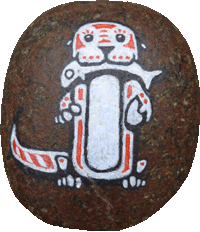It’s clear why Thailand has such a gravitational pull for travellers of all kinds. The country is full of interest, it’s more modern and accommodating than other Asian nations, and the crucial travelling commodities of food, lodging and transport are all cheap and good quality; you can dwell comfortably in Thailand for £20 per day. For prices below, the exchange rate was about B50 to £1 when we visited.
Accommodation
In the north of Thailand our accommodation was always great value and excellent quality; a clean and characterful guest house with breakfast for under £15. Naturally prices were a little higher in Bangkok, and there was also the big city tendency for guest house (and restaurant) staff to be less friendly and helpful, just doing their job. On the sun-soaked Andaman coast you often have less options for a simple guest house, especially if you want an island or beach getaway. Naturally enough the accommodation here is more usually bungalows and resorts, and you either pay more or accept basic. It’s still easy to find a good room for £40 though.
Unless you’ve gone very basic or homestay, you’ll find western toilets everywhere you stay. Most places also supply a couple of bottles of water each day, since the tap water isn’t potable. There are some brands that come in recyclable glass bottles – so if your hotel provides plastic, maybe suggest to the management that they change? Finally, although guest houses and resorts are generally lovely please note that if you head somewhere more adventurous and are offered a “basic bungalow” this can be very basic indeed!
Food
Thailand is famed for good eating, and I’d say justly so. There are roughly four kinds of places to eat: (1) modern indoor restaurants, as you’d recognise from back home; (2) local restaurants, sometimes open-sided with plastic tableware, battered furniture but great food; (3) night markets, which are clusters of several hot and cold food stalls with a shared open air seating area; (4) snack food stalls, in clusters or singly. My own favourite eating was at the local restaurants in Chiang Mai, or grabbing snacks like fried quails eggs with pepper and soy sauce from snack stalls. These snacks are typically 40p, a meal for two at a night market or local restaurant might be £4 with soft drinks, and £8 upwards at a modern restaurant, depending on how posh you go. You would never bother self-catering in Thailand!
Everyone knows Thai food from restaurants back home. The “real thing” has sharper, more defined and stronger flavours. There are lots of great spicy salads. Seafood is very common, and prawns chucked into almost everything; they’re a plentiful staple, not a luxury food. Service is generally great (though English-speaking not common), and the food comes in under five minutes. A plate of rice is standard always, whatever dishes you’ve ordered added to it. We found two or three dishes sufficed for us. Most places assume that western tourists have feeble tastebuds, and when you say you want it spiced to Thai levels they react with amiable surprise.
Don’t forget to eat your fruit! Firstly because a lot of Thai meals are low on veggie content, and secondly because it’s delicious. My own favourites are longans, which have a complicated perfume that stays pungent on the palate. Especially if you scoff a whole bunch at once.
Drink
The staple in Thailand is the “fruit shake”, the fruit of your choice blended with ice to a crush. Personally I don’t like them, the first couple of slurps being flavourful but the melting ice rapidly diluting the taste. You can often get fruit juice instead, perhaps 60p for a glass. And there are loads of fruits to choose from. Drinks are mostly served in plastic, usually disposable. Marginally better for the environment, sometimes they serve fruit shakes in nothing but little plastic bags with a straw stuck in! I was curious as to how often people accidentally stab through the bottom.
Beer is cheaper than back home, but still usually over £1. Thai beer is bright lager, cold and thirst-quenching with little flavour. Wine isn’t relevant in Thailand, so if you insist on it then unless you’re in a very classy restaurant you’ll pay a lot for something crap from Australia or Chile, probably from a box. Don’t bother. Thais prefer to buy a small 250ml bottle of local whiskey for £3 (actually closer to rum) and a couple of bottles of soda water and coke, and drink this with the meal. It works pretty well, and suits the food admirably.
There is excellent coffee to be had in the north, around Chiang Mai especially. Good as London. Didn’t find anything worthy in Bangkok (but we hardly scratched the behemoth’s hide) and the coffee in the south was unremittingly crap. Beware the 3-in-1 sachet! It’s a mixture of coffee, milk powder and sugar but the mixture is intended for someone with a horrifically sweet tooth.
Transport
It’s all good. We hired a car in Chiang Mai for £16 per day, and the roads are of excellent quality with very little traffic and generally good driving by the locals. We didn’t encounter any of the “insane bus drivers” that the guidebooks warn of, even on the Mae Hong Son loop which is supposed to be challenging but was actually just fun. You could even drive in Bangkok, I reckon, the traffic being no worse than London despite the dire guidebook comments.
Without a car you’d tend to get about by tuk-tuk or songthaew, the provincial versions of taxis and buses respectively. £2 in a tuk-tuk or 60p in a songthaew would usually take you the kind of distance a cabbie back home would want £20 for and a bus ride of £2. It’s more expensive in a Bangkok taxi, but they have meters that work and so are much easier than trying to haggle a price out of a grasping Bangkok tuk-tuk driver. One such started at 150 baht with us and had come down to 50 baht before he finally guessed that we were so disgusted with his starting price that we were never going to take his services. In our experience the provincial drivers are less grasping, but a haggle is expected.
Big comfortable buses can take you between cities most cheaply, perhaps just £6 for as many hours, and you always have a seat. We prefer the trains, though. They take a bit longer but cost no more and in 2nd class you are very comfortably seated with plenty of room for luggage. On longer journeys vendors wander the train selling good food and drinks for street prices, so you never even have to get up. Sleeper trains are even better, as we’ve blogged already, but these you definitely need to buy tickets for in advance. You can buy from any train station, not just the one you’re leaving from.
Weather
In December, nominally winter, it was pretty darn hot. Not as humid as Hong Kong, but probably higher temperature. The hottest places were Chiang Mai, Sukhothai and Bangkok; sleeping in a room with no air-conditioner in Sukhothai was difficult. Indeed, the best way to get relief from the heat is to think about where to stay. The coast is cooled by breezes off the water, and so was our floating raft on Khao Sok lake. Up in the hills at Cave Lodge we were almost cold at night. There were several rainy days during our time in Thailand; dry season doesn’t mean wall-to-wall sunshine here as it might elsewhere.
Scams and hassle
We were amazed at how much hassle we didn’t get, even in Bangkok. Some of this is probably down to Maureen’s Asiatic appearance, but we spoke to others who didn’t have much trouble either. Tuk-tuk drivers will ask too much, so just find out first how much the journey ought to be and haggle to somewhere near that. If you look to buy souvenirs you should also be seeking some discount, and people in markets might well start at double the “real” price.
Crime and security
We didn’t see or experience any criminal behaviour in Thailand. The well known sex industry didn’t impinge on us either, even in Bangkok where it seems to be restricted to just a couple of small areas.
Hiking and wildlife
Thailand has loads of national parks, which is to be applauded. But without some kind of guided tour they’re hard to enjoy, typically having just a couple of short marked trails for tourists and with very little English spoken by the park staff. Guided tours are typically pretty good value, just annoying if you like to be independent or have specialist interests. The forests hide lots of brilliant wildlife, but they hide it well; even with a good guide it’s very lucky to see much animal life in the national parks. Monkeys are by far the easiest critters to spot.
We didn’t get any experience of hiking. As mentioned, the national parks only really support organised hikes, and elsewhere in the country you’d get hopelessly lost as an independent walker; the only option would again be an organised tour. There are lots of these available in the north of Thailand, but the term “hill tribe trek” is possibly misleading – you may well be buying a mish-mash of walk, elephant ride, bamboo raft ride, and village ogling over a couple of days. We gave it a miss.
Regional variations
From our own experience, the north of Thailand has better food, much better coffee, cheaper and more consistently good accommodation, and lots to keep you interested unless you are looking for a beach. Chiang Mai is a great place to relax into. Bangkok has typical capital city syndrome; there’s just a bit less helpfulness, a bit more getting-on-with-business. The peninsula south has all the beaches and tourism you could want, all a bit more expensive and of patchier quality. The food is even spicier.
Conclusion
Thailand is a very easy country to like, and will probably be the star of our Asian journey. I like the level of civilisation, but not just for the convenience. Visiting Thailand you are visiting a self-contained and confident country, staying in places that are stayed in by locals tourists and visiting places visited by Thai tourists. This is very different and more satisfying than somewhere like Nepal or Cambodia, where the only people using hotels and attractions are tourists flying in from abroad. It lends itself much better to independent travel, which is what we really like.
We liked best:
- Sea-kayaking to the secret lagoon of Ko Roi in Phang Nga bay
- Exploring caves among the limestone karst of the far north
- Enjoying whiz-bang Loy Krathong celebrations in Chiang Mai
- Watching wildlife on Khao Sok lake from kayaks and longtail boats
- All the lovely food!
- Mosquitoes everywhere. Especially Koh Yao Noi and Hala Bala
- The fantastic New Year dinner at the equally fantastic Kuraburi Greenview Resort (please apply sarcastic tone)
- Thirty four bum-destroying hours in a tiny hide watching for otters
We liked least:
Related Images:














































[…] tourist eating out without research on a journey around Britain. I’d venture to suggest that Thailand and Malaysia are the only two countries I’ve visited where picking a place to eat randomly usually has a […]